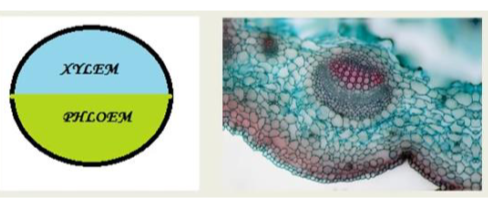Xylem and phloem
Function
The transport system in plants is mainly made of the xylem and phloem tissue.
- Xylem tissue transports water, mineral ions, and solutes from the roots to the leaves.
- Phloem tissue transports nutrients from the leaves to the rest of the plant.
Structure
You need to be able to recognize the xylem & phloem in three different parts of the plant: leaf, stem, and root
Leaf

Stem
Root
Water uptake in roots
Root structure
Water, mineral ions, and other nutrients are absorbed into the plants via the roots.
Root hair cells are cellular extensions which drastically increase the surface area for absorption.
Waters moves from the soil into the xylem via osmosis.
Pathway of water through a plant
Movement in the root
Water in the soil is absorbed into the root hair cells via osmosis. It then makes it way through the root cortex, across the endodermis, and into finally into the xylem.
Movement in the xylem
Water moves up the xylem due to a combination of factors that include: transpirational pool, root pressure, and cohesion.
Transpirational pool is when water leaves the leaf via transpiration and therefore results in negative pressure at the top of the plant.
Root pressure is when water is absorbed in the roots via osmosis resulting to positive pressure at the bottom of the plant.
A column of water is drawn up the plant from low to high pressure. Water molecules ‘stick together’ due to cohesion allowing the entire column of water to be drawn.
Water movement in the xylem is much like water movement in a straw. When you stuck on the top end of the straw it reduces pressure compared to the bottom of the straw. A column of liquid is therefore drawn from low to high pressure. The liquid column sticks together due to cohesion.
Movement in the leaf
Water enters the leaf through the vascular bundle and can move directly into palisade or spongy mesophyll cells to be used for photosynthesis.
Otherwise water evaportates into the air spaces in the spongy mesophyll layer, where they diffuse out via the stomata. We call this transpiration.
Transpiration
Transpiration is the loss of water vapour from leaves via the stomata.
Once water enters the leaf via the xylem vessels of the vascular bundle, it travels to the mesophyll cells to be used in photosynthesis.
Some water remain on the surfaces of these mesophyll cells and evaporate into the air spaces of the spongy mesophyll layer. Water vapour diffuses out of the leave via the stomata.
Factors that affect transpiration rate are:
- Temperature
- Higher temperatures result in faster moving molecules and therefore increases diffusion rate, which in turn, increases transpiration rate
- Humidity
- Higher humidity results in a lower concentration gradient and thus reduces diffusion rate, which in turn, reduces transpiration rate
Translocation
Translocation is the movement of sucrose and amino acids in the phloem from the source to the sink.
- Source is the region of production
- Sink is the region of storage OR where they are used in respiration or growth
Some parts of the plant may act as a source and sink at different times during the plant life.
- Leaves are the source most of the time but can become a sink in periods of growth i.e. after autumn when plants growth their leaves again